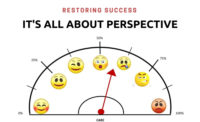Restorers Need to Ask: To Reply All or NOT Reply All

marchmeena29/iStock / Getty Images Plus via Getty images
When I created the weekly tip for success, “Know when to Reply All and NOT to Reply All,” I did not expect to receive so much enthusiastic feedback. After hearing the horror stories, the frustrations and the passion surrounding the topic, it was clear that it demanded an entire article. The topic seems a bit silly and if you are reading it, you may already be reply passionate. I encourage to you to add any reply tips in the comments below for all to enjoy. You can use this article as a tool to help train and inspire good reply to etiquette.
Email is one of the most popular forms of communicating in our day-to-day lives. It comes in all forms: Internal, external, instructions, updates, announcements, junk, and more. For many, it is a critical means of communication that we rely on to function.
It is also a skill to use properly. Like all forms of communication, it reflects on our presentation and professionalism. We have to “manage” the email madness. In my ongoing personal quest to “Stop the Email Madness,” I estimate that I probably spend about 3 hours a week deleting unnecessary “Reply Alls” or the more complex redistribution of information to others because the respondent did not appropriately “Reply All.” This can cause a flurry of broken communication and inefficiency. Some of you may have had or observed embarrassing situations from haphazard replying. Some of you may have thought or said, “Stop Replying to All!” Proper replying leads to improved email effectiveness and efficiency for all.
REPLY TO ALL
The following is a list of things to consider while applying good judgement:
- Small groups of participants
- Work plans, questions and answers, meeting follow ups, etc.
- Consider that the creator of the string was deliberate on who was on the initial email
- Whenever everyone on the email needs to know the response; this can apply to a variety of scenarios. This is my personal number one passion as I have to recommunicate with people who get disconnected because someone should have “Replied All”
NOT REPLY TO ALL
Another short list of considerations that should be applied with good judgement:
- Large groups
- General announcements, Dissemination of information, etc.
- Thank you. I do like thanking and acknowledging, however, imagine an email with 50+ people and each one replies to all with a Thank you. That is fifty extra thank you emails to delete. If is it a large group and I want to express enthusiasm or gratitude, I will sometimes simply thank the sender.
- Donotreply senders: This is not a person by the name of Dona Reply; this is from an account that is not designed to Reply to All – Do Not Reply = donotreply.
- When saying something inappropriate or you may not want someone on the string to see, proceed with caution. Or do not share your thoughts in email at all. Yes, there are many horror stories here. Which leads to….
- Pay attention to who “All” is…pay attention in general. Someone may have included the wrong contact by mistake (guilty!). Maybe a key person was missed. Maybe the person replied to only you with information that is needed by others.
OTHER REPLYING ETIQUETTE
REPLY: This sounds simple. It can be difficult to keep up with our email communications. We also have the added complexity of checking our Junk and Spam filters to make sure that important communications are not overlooked. We cannot ignore emails, or not respond in a timely manner, because it can have a ripple effect that includes straining relationships, workflow issues, and more. Not replying to an email can be the equivalent of saying, I do not care, I am not listening, I do not want to collaborate with you and more. I personally strive to be timely and diligent in my replying. Even with my “reply to” passion, I sometimes falter on my own best practices. I take it seriously, apologize, and work to get better.
MOVE SOMEONE TO Bcc: This is good etiquette when being connected to someone and an email string will ensue that is not relevant to the connector. It may sound like: Jane, I thank you for connecting me to Tom, I have moved you to BCC. I will coordinate the next steps with Tom.
ANNOUNCE CONTACTS THAT YOU ADD: Consider this the equivalent of announcing that you put someone on speaker phone and those who are present for the call. I do this often when needing to facilitate or inform key people that I work with. It may sound like: I have added Joe, Director, who can help us facilitate the next steps.
FORWARD: This was a special request for the article. Be thoughtful and considerate when forwarding emails and/or adding people when it may not have been the intention of the sender to share. If in doubt, ask the original sender. If you do appropriately forward an email to inform others, forward it with an FYI or brief description. This will allow the receiver to know if there is an action item in the email or if you are just passing along information to keep them in the loop.
BCC: If you were Bcc’d, it was likely the intention of the creator that you are not to reply, and you are only on the string for informational or awareness purposes.
JUNK AND SPAM: I was recently on a string that was a fraudulent invoice. All participants were Bcc’d. Many of those in receipt, began replying and then began replying to all. All the participants became exposed further, and it was an email scam mayhem string of replying to all. Finally, someone said, “STOP REPLYING TO ALL!”
Related Reading
TIPS TO EMAIL CREATORS: To help control bad replying, as the creator, you can help manage the situation.
- Use To, Cc, and Bcc deliberately. As a rule, the TO contacts have some kind of action item. Ccs are there for the information and possible ensuing communications.
- Tell the recipients how to reply. Please Reply All with your response. Or Reply with questions directly to me.
Email etiquette is something we have to train on and talk about. I hope this seemingly silly topic can contribute to your Restoring Success.
Looking for a reprint of this article?
From high-res PDFs to custom plaques, order your copy today!






